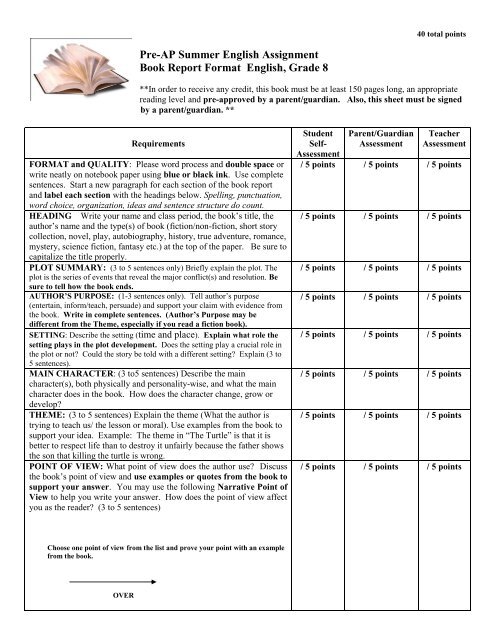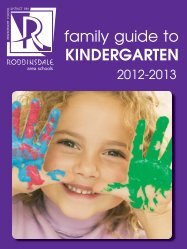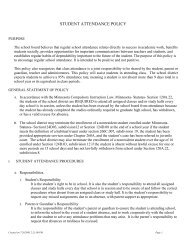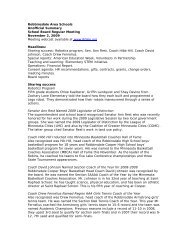Pre-AP Summer English Assignment Book Report Format English ...
Pre-AP Summer English Assignment Book Report Format English ...
Pre-AP Summer English Assignment Book Report Format English ...
- No tags were found...
Create successful ePaper yourself
Turn your PDF publications into a flip-book with our unique Google optimized e-Paper software.
40 total points<strong>Pre</strong>-<strong>AP</strong> <strong>Summer</strong> <strong>English</strong> <strong>Assignment</strong><strong>Book</strong> <strong>Report</strong> <strong>Format</strong> <strong>English</strong>, Grade 8**In order to receive any credit, this book must be at least 150 pages long, an appropriatereading level and pre-approved by a parent/guardian. Also, this sheet must be signedby a parent/guardian. **RequirementsFORMAT and QUALITY: Please word process and double space orwrite neatly on notebook paper using blue or black ink. Use completesentences. Start a new paragraph for each section of the book reportand label each section with the headings below. Spelling, punctuation,word choice, organization, ideas and sentence structure do count.HEADING Write your name and class period, the book’s title, theauthor’s name and the type(s) of book (fiction/non-fiction, short storycollection, novel, play, autobiography, history, true adventure, romance,mystery, science fiction, fantasy etc.) at the top of the paper. Be sure tocapitalize the title properly.PLOT SUMMARY: (3 to 5 sentences only) Briefly explain the plot. Theplot is the series of events that reveal the major conflict(s) and resolution. Besure to tell how the book ends.AUTHOR’S PURPOSE: (1-3 sentences only). Tell author’s purpose(entertain, inform/teach, persuade) and support your claim with evidence fromthe book. Write in complete sentences. (Author’s Purpose may bedifferent from the Theme, especially if you read a fiction book).SETTING: Describe the setting (time and place). Explain what role thesetting plays in the plot development. Does the setting play a crucial role inthe plot or not? Could the story be told with a different setting? Explain (3 to5 sentences).MAIN CHARACTER: (3 to5 sentences) Describe the maincharacter(s), both physically and personality-wise, and what the maincharacter does in the book. How does the character change, grow ordevelop?THEME: (3 to 5 sentences) Explain the theme (What the author istrying to teach us/ the lesson or moral). Use examples from the book tosupport your idea. Example: The theme in “The Turtle” is that it isbetter to respect life than to destroy it unfairly because the father showsthe son that killing the turtle is wrong.POINT OF VIEW: What point of view does the author use? Discussthe book’s point of view and use examples or quotes from the book tosupport your answer. You may use the following Narrative Point ofView to help you write your answer. How does the point of view affectyou as the reader? (3 to 5 sentences)StudentSelf-AssessmentParent/GuardianAssessmentTeacherAssessment/ 5 points / 5 points / 5 points/ 5 points / 5 points / 5 points/ 5 points / 5 points / 5 points/ 5 points / 5 points / 5 points/ 5 points / 5 points / 5 points/ 5 points / 5 points / 5 points/ 5 points / 5 points / 5 points/ 5 points / 5 points / 5 pointsChoose one point of view from the list and prove your point with an examplefrom the book.OVER
Narrative Point of ViewOne of the most important decisions a writer makes as she writes a story isthe narrative point of view she will use. The point of view is thestory's perspective. Through whose eyes will you, the reader,see this story? Read the choices below and then choose whichpoint of view your book employs:First person--Uses "I" or "we." Many times the narrator is the protagonist, but this is notalways true. In this point of view the reader only knows the thoughts of thenarrator as he relates the story.Third person limited omniscient--Uses "he," "she," or "they." This point of view is the next closest thing tofirst person. Although the narrator uses 3rd person, the reader still onlyknows the thoughts of one character, the protagonist.Third person omniscient--Uses "he" "she" or "they." This point of view gives the reader insight intoall of the main characters. Flat characters' thoughts are not usually revealed.(It gets confusing to know everyone's thoughts.)Third person objective--Uses "he" "she" or "they." In this point of view, the narrator does not revealthe thoughts of any of the characters. This point of view is often called the"fly on the wall" point of view, because the only insight the reader has into acharacter is by what he says, by what he does, and by what others say to him.Adapted from Candace Schaeferhttp://english.tyler.cc.tx.us/engl2307nbyr/narrativepov.htmTotal Score /40 points / 40 points / 40 pointsParent Signature:Additional Comments:







